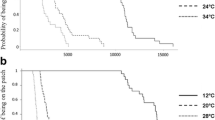Summary
Individual Coenonympha pamphilus males shifted mate locating behaviour depending on temperature. Under low temperature conditions males competed for territories, resulting in a high proportion of potential territories being occupied by stationary males and in long interactions between males in teritories. When temperatures became higher, stationary males tended to leave their territories and travel over a wider area, i.e. become vagrant. This resulted in a low proportion of territories being occupied by stationary males and inshort territorial interactions. Males could stay longer in flight without perching and hence also search a larger area for females within a given time span with increasing temperatures. This may explain why males adopt vagrant behaviour at higher temperatures. Al lower temperatures, on the other hand, when males cannot search effectively for females, waiting for them at a defended territory should be the most successful strategy.
Similar content being viewed by others
References
Alcock J (1983) Territoriality by hilltopping males of the great purple hairstreak, Atlides halesus (Lepidoptera, Lycaenidae): convergent evolution with a pompilid wasp. Behav Ecol Sociobiol 13:57–62
Austin GT (1977) Notes on the behavior of Asterocampa leilia (Nymphalidae) in southern Arizona. J Lepid Soc 31:111–118
Baker RR (1972) Territorial behaviour of the nymphalid butterflies, Aglais urticae (L.) and Inachis io (L.). J Anim Ecol 41:453–469
Baker RR (1983) Insect territoriality. Annu Rev Entomol 28:65–89
Bitzer RJ, Shaw KC (1979) Territorial behaviour of the red admiral Vanessa atalanta. J Res Lepid 18:36–49
Bitzer RJ, Shaw KC (1983) Territorial behavior of Nymphalis antiopa and Polygonia comma (Nymphalidae). J Lepid Soc 37:1–13
Brown JL (1975) The evolution of behavior. Norton, New York
Church NS (1960) Heat loss and the body temperatures of flying insects. II. Heat conduction within the body and its loss by radiation and convection. J Exp Biol 37:186–212
Davies NB (1978) Territorial defence in the speckled wood butterfly (Pararge aegeria): The resident always wins. Anim Behav 26:138–147
Digby PSB (1955) Factors affecting the temperature excess of insects in sunshine. J Exp Biol 32:279–298
Douwes P (1975a) Territorial behaviour in Heodes virgaureae L. (Lepidoptera: Lycaenidae) with particular reference to visual stimuli. Norw J Entomol 22:143–154
Douwes P (1975b) Distribution of a population of the butterfly Heodes virgaureae. Oikos 26:332–340
Enquist M, Leimar O (1983) Evolution of fighting behaviour: Decision rules and assessment of relative strength. J Theor Biol 102:387–410
Kingsolver JG (1983) Ecological significance of flight activity in Colias butterflies: implications for reproductive strategy and population structure. Ecology 64:546–551
Lederhouse RC (1982) Territorial defense and lek behavior of the black swallowtail butterfly, Papilio polyxenes. Behav Ecol Sociobiol 10:109–118
Leigh TF, Smith RF (1959) Flight activity of Colias philodice eurytheme Boisduval in response to its physical environment. Hilgardia 28:569–624
Lundgren L (1977) The role of intra-and interspecific male: male interactions in Polyommatus icarus Rott and some other species of blues (Lycaenidae). J Res Lepid 16:249–264
Parry DA (1951) Factors determining the temperature of terrestrial arthropods in sunlight. J Exp Biol 28:445–462
Powell JA (1968) A study of area occupation and mating behavior in Incisalia iroides (Lepidoptera: Lycaenidae). J NY Entomol Soc 76:47–57
Rohlf FJ, Sokal RR (1981) Statistical tables. Freeman, San Francisco
Scott JA (1974) Mate-locating behavior of butterflies. Am Midl Nat 91:103–117
Shields O (1967) Hilltopping. An ecological study of summit congregation behavior of butterflies on a southern California hill. J Res Lepid 6:69–178
Shreeve TG (1984) Habitat selection, mate location, and microclimatic constraints on the activity of the speckled wood butterfly Pararge aegeria. Oikos 42:371–377
Suzuki Y (1976) So-called territorial behaviour of the small copper, Lycaena phlaeas daimio Seitz (Lepidoptera: Lycaenidae). Kontyû 44:193–204
Tinbergen N (1972) The courtship of the grayling Eumenis (= Satyrus) semele (L).. In: The animal in its world; field studies. Allen & Unwin, London, pp 197–248
Thornhill R, Alcock J (1983) The evolution of insect mating systems. Harvard University Press, Cambridge, Mass
Vielmetter W (1958) Physiologie des Verhaltens zur Sonnenstrahlung bei dem Tagfalter Argynnis paphia L. I. Untersuchungen im Freiland. J Insect Physiol 2:13–37
Whalley P (1981) The Mitchell Beazley pocket guide to butterflies. Mitchell Beazley Publishers, London
Wickman P-O (in press) Territorial defence and mating success in males of the small heath butterfly, Coenonympha pamphilus (L.) (Lepidoptera: Satyridae). Anim Behav
Wickman P-O, Wiklund C (1983) Territorial defence and its seasonal decline in the speckled wood butterfly (Pararge aegeria). Anim Behav 31:1206–1216
Author information
Authors and Affiliations
Rights and permissions
About this article
Cite this article
Wickman, PC. The influence of temperature on the territorial and mate locating behaviour of the small heath butterfly, Coenonympha pamphilus (L.) (Lepidoptera: Satyridae). Behav Ecol Sociobiol 16, 233–238 (1985). https://doi.org/10.1007/BF00310985
Received:
Accepted:
Issue Date:
DOI: https://doi.org/10.1007/BF00310985




